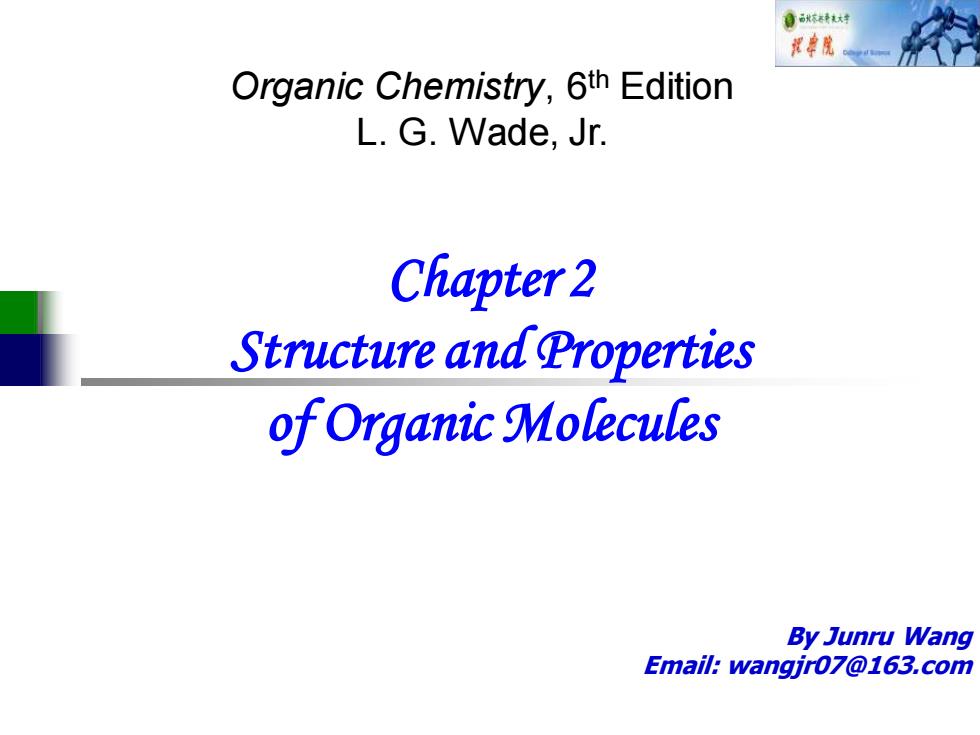
自秋不转大对 花华就 Organic Chemistry,6th Edition L.G.Wade,Jr. Chapter 2 Structure and Properties of Organic Molecules By Junru Wang Email:wangjr07@163.com
By Junru Wang Email: wangjr07@163.com Chapter 2 Structure and Properties of Organic Molecules Organic Chemistry, 6th Edition L. G. Wade, Jr
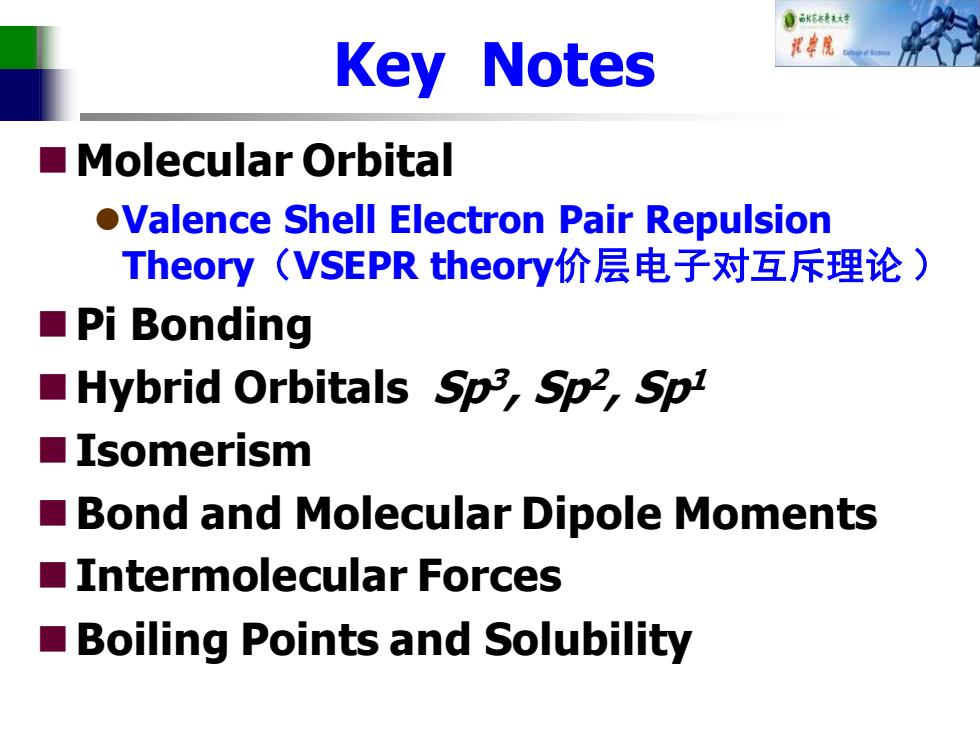
自秋不转大材 Key Notes ■Molecular Orbital oValence Shell Electron Pair Repulsion Theory(VSEPR theory价层电子对互斥理论) ■Pi Bonding Hybrid Orbitals Sp3 Sp2 Sp ■Isomerism Bond and Molecular Dipole Moments Intermolecular Forces Boiling Points and Solubility
Key Notes ◼Molecular Orbital ⚫Valence Shell Electron Pair Repulsion Theory(VSEPR theory价层电子对互斥理论 ) ◼Pi Bonding ◼Hybrid Orbitals Sp3 , Sp2 , Sp1 ◼Isomerism ◼Bond and Molecular Dipole Moments ◼Intermolecular Forces ◼Boiling Points and Solubility
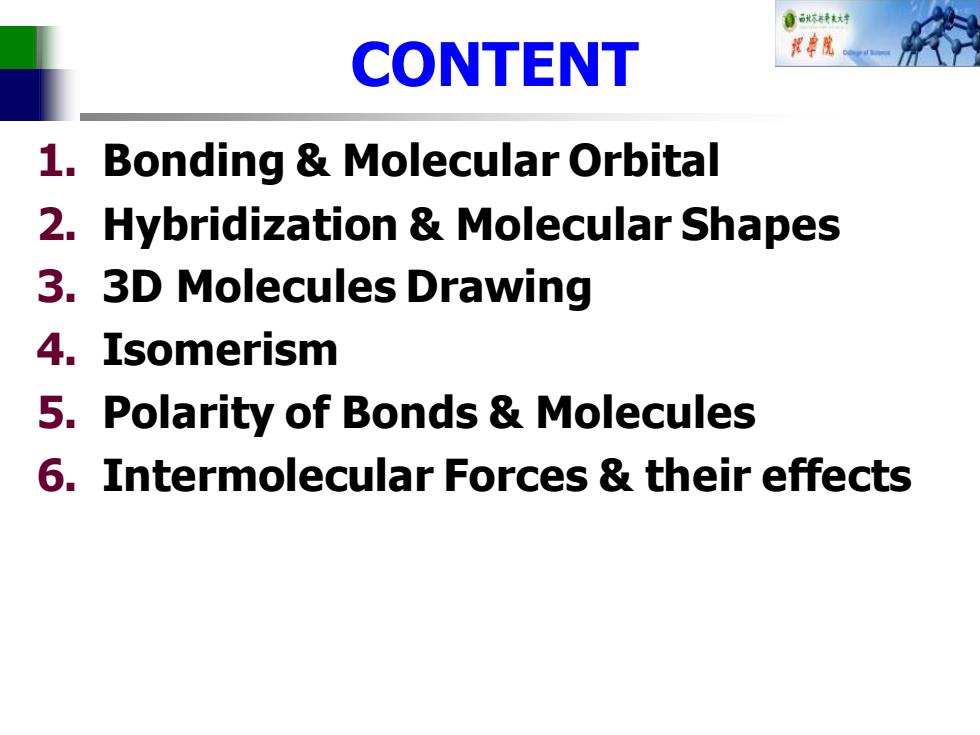
自秋水特 CONTENT 教华魔 1.Bonding Molecular Orbital 2.Hybridization Molecular Shapes 3.3D Molecules Drawing 4.Isomerism 5.Polarity of Bonds Molecules 6.Intermolecular Forces their effects
CONTENT 1. Bonding & Molecular Orbital 2. Hybridization & Molecular Shapes 3. 3D Molecules Drawing 4. Isomerism 5. Polarity of Bonds & Molecules 6. Intermolecular Forces & their effects
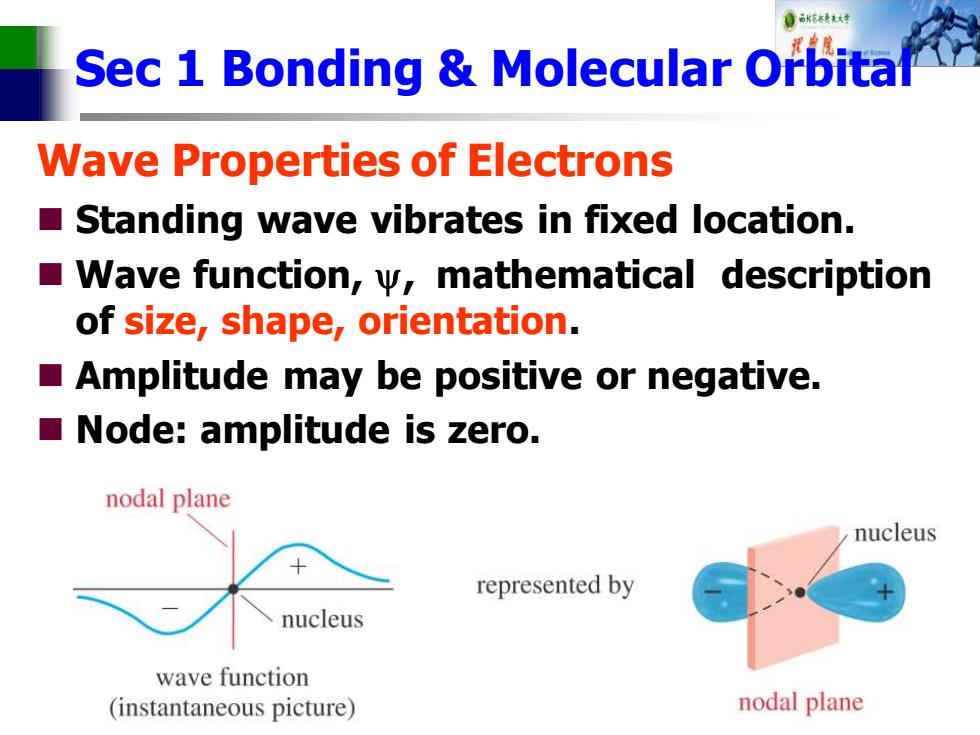
自秋特大材 Sec 1 Bonding Molecular Orbita Wave Properties of Electrons Standing wave vibrates in fixed location. ■ Wave function,w,mathematical description of size,shape,orientation. Amplitude may be positive or negative. Node:amplitude is zero. nodal plane nucleus represented by nucleus wave function (instantaneous picture) nodal plane
Sec 1 Bonding & Molecular Orbital Wave Properties of Electrons ◼ Standing wave vibrates in fixed location. ◼ Wave function, , mathematical description of size, shape, orientation. ◼ Amplitude may be positive or negative. ◼ Node: amplitude is zero
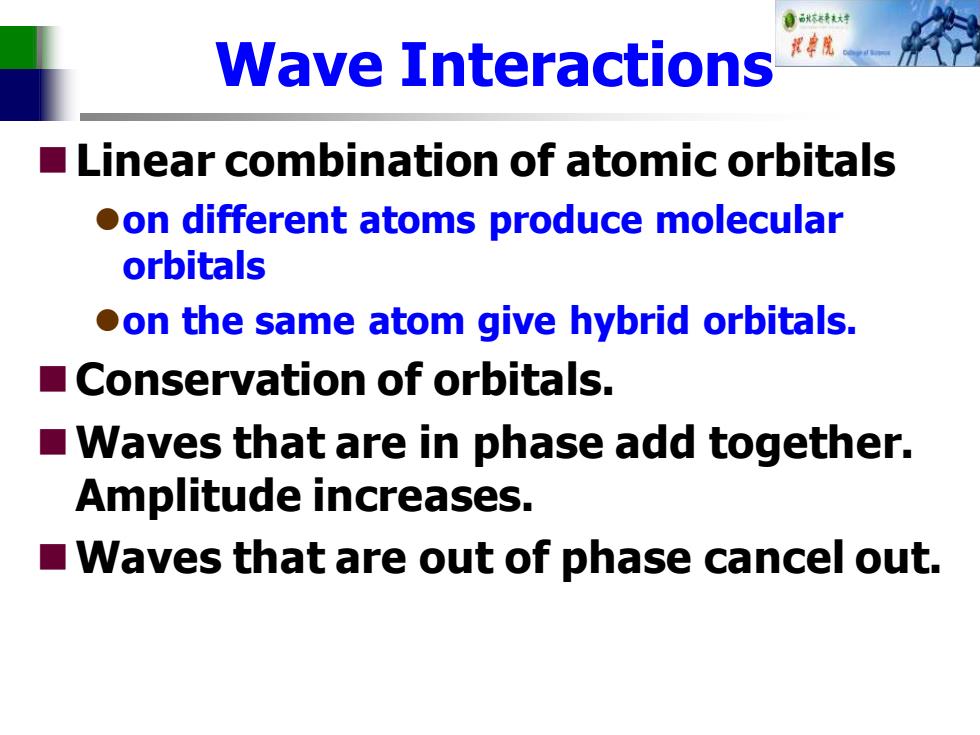
Wave Interactions Linear combination of atomic orbitals oon different atoms produce molecular orbitals oon the same atom give hybrid orbitals. Conservation of orbitals. Waves that are in phase add together. Amplitude increases. ■ Waves that are out of phase cancel out
Wave Interactions ◼Linear combination of atomic orbitals ⚫on different atoms produce molecular orbitals ⚫on the same atom give hybrid orbitals. ◼Conservation of orbitals. ◼Waves that are in phase add together. Amplitude increases. ◼Waves that are out of phase cancel out

自标4花对 Bonding Region ■ Electrons are close to both nuclei. bonding region ● electrons in this region nucleus 1 nucleus 2 attract both nuclei and mask the positive charges from repelling each other Copyright2005 Pearson Prentice Hall,Inc
Bonding Region ◼Electrons are close to both nuclei
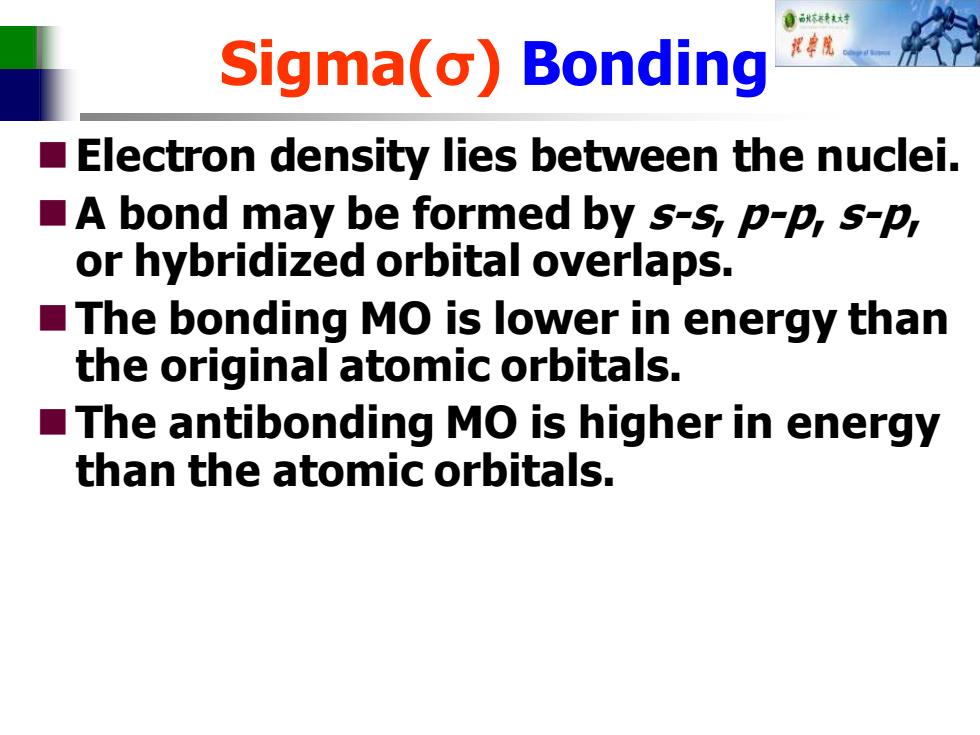
Sigma(o)Bonding ■ Electron density lies between the nuclei. A bond may be formed by s-s,p-p,s-p, or hybridized orbital overlaps. ■ The bonding MO is lower in energy than the original atomic orbitals. The antibonding MO is higher in energy than the atomic orbitals
Sigma(σ) Bonding ◼Electron density lies between the nuclei. ◼A bond may be formed by s-s, p-p, s-p, or hybridized orbital overlaps. ◼The bonding MO is lower in energy than the original atomic orbitals. ◼The antibonding MO is higher in energy than the atomic orbitals
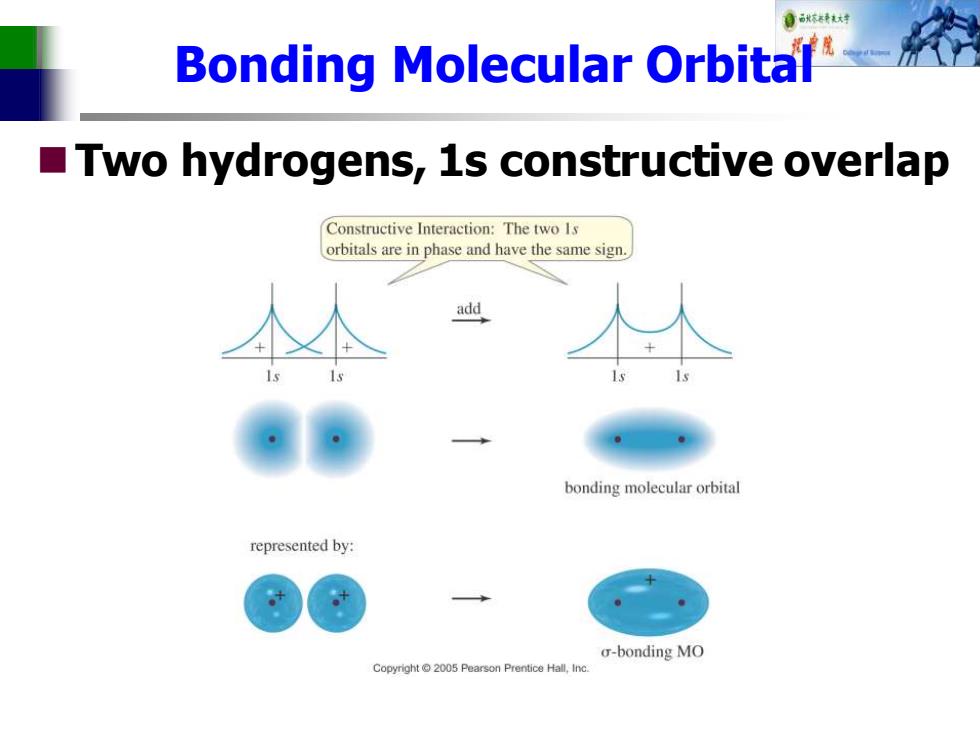
Bonding Molecular Orbital Two hydrogens,1s constructive overlap Constructive Interaction:The two Is orbitals are in phase and have the same sign. add bonding molecular orbital represented by: o-bonding MO Copyright2005 Pearson Prentice Hall,Inc
Bonding Molecular Orbital ◼Two hydrogens, 1s constructive overlap

自秋对 Anti-Bonding Molecular Orbital Two hydrogens,destructive overlap. Destructive interaction:The two Is orbitals are out of phase. anubonding molecular orbital represented by: node aantibonding MO Copyright2005 Pearson Prentice Hall,Inc
Anti-Bonding Molecular Orbital ◼Two hydrogens, destructive overlap

自秋转大材 花单院 H,:s-s overlap node antibonding 0* energy atomic orbital atomic orbital bonding molecular orbital Copyright 2005 Pearson Prentice Hall,Inc
H2 : s-s overlap